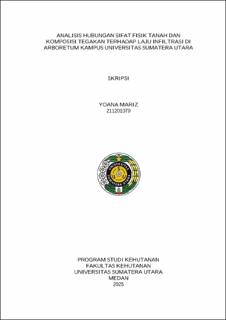| dc.description.abstract | This study aims to analyze the relationship between soil physical properties and stand composition on infiltration rate at the Arboretum of the University of North Sumatra. Infiltration is a crucial process in the hydrological cycle that influences groundwater availability and surface runoff control. The study was conducted on 12 blocks with varying vegetation and soil characteristics. Observed soil physical parameters included texture, moisture content, and organic matter. Stand composition was analyzed based on diversity, species richness, and evenness across four growth strata: seedlings, saplings, poles, and trees. Infiltration rate was analyzed using the Horton and Kostiakov models, with calibration assessed through RMSE and NSE values. Results indicated that the Horton model provided a more accurate representation of infiltration behavior, as shown by lower RMSE and higher NSE values compared to the Kostiakov model. Pearson correlation analysis showed that sand and organic matter content had a strong positive correlation with infiltration rate, while clay content and soil moisture had a negative correlation. Measuring infiltration rate is essential for future soil conservation planning and water resource management. The data can serve as a basis for arboretum management, land use planning, and mitigation of hydrological risks. A comprehensive understanding of the factors affecting infiltration also supports sustainable ecosystem management. | en_US |


